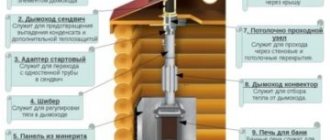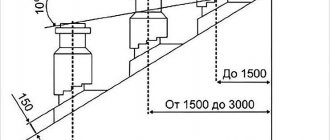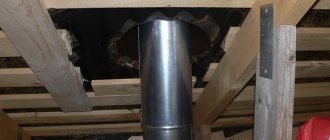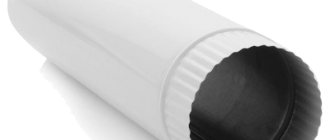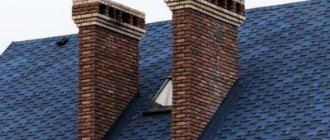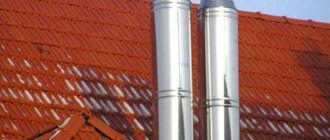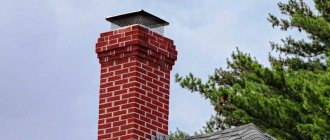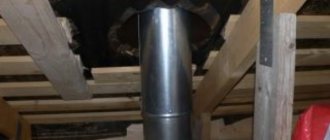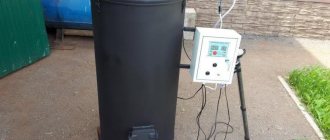The heating installation of any country property consists of a heating element (stove, fireplace or stove) and a flue gas exhaust system.
The chimney belongs to the system for removing carbon monoxide into the atmosphere and is the connecting link between the combustion plant and the chimney. During operation of the heating communication, a very high temperature of more than 700°C rises inside the chimney. When exposed to heat, the pipes become deformed. The entire structure of the chimney is distorted, ruptures and cracks appear.
The movement of flue gases in the chimney is disrupted. Carbon monoxide begins to penetrate into the living room and settle on the surface of the pipes. It becomes impossible to live in such a room. The accumulation of soot on pipes provokes the formation of condensation and can be a source of fire in the chimney.
General information
Depending on the material of manufacture, chimneys are:
- Brick;
- Steel single-circuit;
- Steel sandwich chimney;
- Ceramic;
- Asbestos-cement;
- Polymeric.
Therefore, it is very important when installing a chimney to choose the right sealing method and material. This will preserve the integrity of the output design and make it resistant to mechanical and other loads.
Types of sealant
In hardware stores you can see a wide range of sealing products. They can be divided into several groups:
Composition based on silicone and silicate;- By the number of components - one-component and two-component;
- Temperature-resistant and heat-resistant sealants.
One-component sealants are easy to use and are often used to insulate chimney structures. They contain one component. No mixing required before use.
Two-component preparations for work are mixed according to instructions in strict proportions. And must be used within two hours. The use of such isolating agents is mainly observed among professionals.
Heat-resistant and heat-resistant sealants
To seal chimneys, heat-resistant and temperature-resistant sealants are mainly used. The differences between the sealants of this group are the size of the temperature regime and the location of the area to be sealed.
Heat-resistant sealants are insulation products that retain their properties at very high temperatures up to 1300°C, and under light loads - up to 1600°C. They are produced on a mineral (silicate) basis. I have dark gray or black color. Ideal for connecting joints in chimney ducts made of steel and stainless steel, as well as for sealing surfaces of brick parts.
Fire-resistant silicate allows you to treat cracks in fireplaces and stoves with direct contact of the sealant with fire.
Advantages:
- Can be used for sealing structures made of any material due to chemical inertness;
- The silicate base is resistant to ultraviolet radiation and all weather conditions. Can be used for treating chimneys outdoors.
- Due to the porosity of the top layer, it allows for additional processing;
- Has high water permeability.
- Has increased strength after the hardening process;
What means are used to create a tight connection?
Special polymer-based compounds have been developed for sealing chimneys, stoves and fireplace inserts. Temperature sealants have a gel-like, fluid consistency, which allows them to flow into the smallest cavities, joints, and cracks. They differ in composition and have different operating temperature limits. Most are produced in special cylinders compatible with the mounting gun.
Note! The uniqueness of sealing compounds for furnaces is that, in addition to their resistance to high temperatures, they are not destroyed by repeated, significant changes in temperature - from -60 to +250 and above.
Sealants for heating systems differ in several parameters:
- according to the constituent components - there are two and one component;
- according to acidity level – acidic and neutral;
- in relation to temperature effects - divided into heat-resistant (low-temperature) and heat-resistant (high-temperature);
- by consistency - gels, pastes.
We recommend that you read: Rules for selecting and installing corrugations for wires and cables
Single-component formulations are sold in one bottle. They are ready to use and do not require additional preparation. These insulating compounds are popular among craftsmen. Their use does not require specific knowledge or skills. When applied to a surface, they harden at room temperature for a certain time.
Two-component heat-resistant sealants consist of two substances, each of which is placed in a separate container. The basis is a polymer; the addition is a catalyst that promotes the solidification of this polymer. Before use, a two-component insulator is prepared by mixing the ingredients. Violation of the proportions or technology of preparing the mixture leads to loss of sealing qualities. The finished mixture has virtually no shelf life. It should be used for a short period of time.
Note! Difficulties in preparing two-component compositions for work lead to the fact that non-specialists do not risk using them. Such sealants are used by professional stove makers and builders.
Heat-resistant compositions include those whose upper limit is limited to 150-250 degrees. They are intended for the external walls of stoves, fireplaces, and brick chimneys.
Heat-resistant or high-temperature sealants are called sealants, the resistance of which reaches a value of 1500 degrees. These compounds can be used not only for the inside of steel pipes, but also in open fire zones - to seal seams and burnouts in a fireplace or stove insert.
Note! A special group consists of polymer adhesives and sealants of the MS brand. These are high-strength polyurethane compounds that can withstand temperatures up to 200 degrees, do not collapse under the influence of ultraviolet radiation, atmospheric influences, retain elasticity, and have increased adhesion to the surfaces being connected.
Polymer adhesives-sealants are rapidly gaining popularity in the construction, industrial (including machine-building) segment of European countries.
In everyday life, for gas and electric stoves, adhesive-sealant type Dow Corning Q3 - 1566 is used.
We recommend that you read: Which gutters for water collection should you prefer: metal or plastic?
Operating rules
When working with fire-resistant sealants, you must follow some rules:
Work with insulating surfaces is carried out up to +40°C and standard humidity;- To obtain a strong connection, the joining places must have roughness. Therefore, before gluing, they must be treated with abrasive materials, degreased with acetone, and allowed to dry;
- Due to the increased strength of the seam, it is not advisable to use this sealant for elements operating under vibration conditions.
Heat-resistant sealants are made on a silicone base. They are used in areas with temperatures up to 350 °C and only when assembling the external surfaces of stoves and chimneys made of natural brick.
When using such a sealant, not only the temperature is important, but also the thickness of the applied layer. During polymerization, the insulator uses moisture from the air. And if more layers are applied than indicated in the instructions, there is a chance that you will not get a strong connection between the surfaces.
There are two types of silicone sealants:
During polymerization, sealants release water and alcohols into the environment. These substances do not affect the chimney material, so they can be safely used when sealing stainless steel chimney structures. And iron oxide, formed as a result of high temperatures, due to its brown color makes the fact of gluing more invisible.
Neutral- Acidic sealants, unlike neutral ones, produce acetic acid during hardening, which can lead to corrosion of the metal elements of the chimney and destruction of the contacting surfaces of the roof. Therefore, they are not used to seal the chimney system.
Advantages of heat-resistant sealant:
- They stand out for their great ability to glue different surfaces made of ceramics, glass, brick, and soft roofing materials.
- Due to its high flexibility after polymerization, this type of sealant allows you to maintain the strength of the connection under the influence of temperature conditions, as well as vibrations of the open parts of the chimney;
- Moisture resistance and ultraviolet resistance make these materials indispensable for sealing the external elements of the chimney and installing pipes for various purposes on the roof.
Heat resistant sealants
This type of sealing materials is produced on a silicate basis, which makes them stable at temperatures close to 1300-1500 °C. Some of them can even withstand temperatures of 1600 °C for a certain time.
In this case, they are dark gray or black in color and are called fire-resistant pipe sealants (the word “fire-resistant” is on the outside of the tube or package).
Some important rules when using heat-resistant sealants:
- Work with silicate sealing materials is carried out in the temperature range of +5 - +40 °C.
- The required sealing effect is achieved only in the case of rough and uneven surfaces. For this purpose, if necessary, the areas where the composition is applied are treated with abrasive materials.
- In addition, the surfaces should be degreased with acetone and then allowed to dry for 15-20 minutes.
- When the paste hardens in places where the sealant is applied, very strong and hard seams are obtained, so it is not recommended to use heat-resistant compounds for structures operating in vibration conditions.
- Traces of sealing material can be removed with a wet cloth or rag, but only before the material hardens. After hardening, this will require the use of mechanical force and some simple tools.
Cement
Sealing a chimney with cement has been a long-forgotten method since the last century. However, it is still used today. The binding agent in this case is an asbestos-cement mixture in a 1:1 ratio.
The mixture is prepared by hand as follows:
- I fill the asbestos with water and bring it to a homogeneous mass;
- A homogeneous and swollen mass of asbestos is mixed with a portion of cement;
- The mixture is coated with the joint between the roof and the chimney;
- Operation of the chimney system is possible after the sealing mixture has completely dried.
Heat-resistant chimney sealant: recommendations for selection
During use and operation of any heating equipment or system, the need often arises to use special sealing agents. But, you need to take into account the fact that such mixtures are exposed to high temperatures and you need to choose only a heat-resistant sealant for your chimney.
Most often, owners of old brick chimneys encounter problems. Cracking of components occurs due to too high a temperature difference. At the same time, the cracks that arise can certainly have through holes, that is, they go far into the firebox and go out into the heated room, why this is dangerous, I think there is no need to explain to anyone reading it.
In addition, the formed cracks affect the formation of soot and soot, over time radically complicating the formation of normal chimney draft. Moreover, problems with cracks or disconnections can plague not only brick channels, but even metal and ceramic ones. Cracking also often occurs at joints due to changes, so it is important to use special sealing agents during installation.
What to look for when looking for sealant
When choosing a sealant, the following points must be taken into account:
- Operating conditions of the heating device;
- Location of the joint or seam (inside the pipe, outside the chimney or on the roof);
- Temperature regime of the treated surface: Heat-resistant agents are mainly used to seal chimneys
- Consistency and composition of the sealant: solid silicone is best used for cracks in brickwork;
- Material for the manufacture of chimney elements.
A properly selected sealant will save you from unexpected expenses for cleaning or disassembling the chimney installation.
Distinctive properties of high-temperature sealants from heat-resistant ones
High-temperature sealing compounds are produced on a silicate (mineral) basis. Silex translated from Latin means stone. Hence the exceptional resistance of these products to significant temperatures, up to a temperature of 1500 °C.
The main difference between heat-resistant sealants and simply heat-resistant ones is their application. If low-temperature insulators are used for external seams, then heat-resistant ones are not limited in location. They can reliably insulate the inner surface of the seams of the refractory masonry of the furnace or fireplace, the inside of the smoke exhaust ducts, where temperature values reach a maximum.
Note! Sealants of this class are labeled as fire-resistant. Their color varies from gray to black.
Features of using heat-resistant insulators:
- Unlike heat-resistant sealants, fire-resistant sealants have weak adhesion to surfaces. In order for the material to be sufficiently fixed, the surface must first be degreased and sanded, giving it the necessary roughness.
- These products have less elasticity when cured, unlike silicone insulators. Avoid applying them to surfaces that are subject to mechanical stress or vibration.
- You can work with heat-resistant insulators only at positive ambient temperatures (from 5 to 40 degrees).
Expert advice
The construction of a proper chimney system is the basis for the efficient and safe operation of heating equipment. If you plan to assemble it yourself, then advice from masters - professionals in this field - will not be superfluous.
Subtleties of switching from a brick pipe to a sandwich
At the point of transition from a brick pipe to a sandwich, it is better to install not a homemade, but a ready-made metal adapter. Its lower part corresponds in size to a brick channel, and the upper part has a round shape with a diameter equal to the diameter of the sandwich. A reliable heat insulator is already installed inside. The use of this device ensures the necessary tightness and fire safety of the connection.
Subtleties of passing through a wooden roof
When using ready-made polyurethane foam, it is necessary to take into account that wood can expand at high humidity, so there should be a small gap between the walls of this device and the opening, approximately 3 - 5 mm. In addition, it is important to impregnate the wood in the joint area with anti-friction agents, which increase its fire resistance.
Where is the best place on the roof to install the pipe?
It is better to move the place where the pipe exits through the roof slightly from the ridge to one side. If it passes through the ridge, then when installing the passage unit, it will be necessary to violate the integrity of the rafters and the ridge beam.
Where is the best place on the wall to make a conclusion?
It is advisable to cut a hole in the wall at the level of the boiler connecting pipe, the main thing is that there are no communications in this place. If you choose a higher place for the outlet of the gas duct, then additional transition elements and installation of horizontal sections will be required, which will negatively affect the draft.
Protecting wood from hot pipes
In the place where the gas duct passes through a wooden wall, a rectangular opening should be cut and a special unit, PPU, should be installed. This is a universal design and is used not only for fire protection of floors, but also walls. The pipe will pass through it, and the free space in the housing can be filled with basalt wool.
How much could such work cost?
Of course, the cheapest option is for the homeowner to assemble the chimney himself. But nevertheless, it is better to invite professionals to perform this work. It is only at first glance that the installation of the structure does not seem at all difficult, but during the process various problems may arise that only experienced specialists can solve. The cost of assembly and installation work depends on the total length of the channel, the method of its placement, the number of overlaps and varies among different craftsmen from 1,700 to 2,000 rubles per meter.
Diagram with internal structure
Elements of the chimney system in the diagram:
- A heating device with a vertical pipe for connecting a chimney in the upper part of the firebox.
- Connection unit for the chimney from the boiler, which includes a 90º inspection tee, a plug - an inspection hatch, a plug with a condensate drain and a 90º connection tee.
- Mono-pipe is a section of a smoke exhaust duct without thermal insulation. It is located in close proximity to the boiler. The need for such a section is explained by the maximum temperature effect on this zone of the structure, so there is a need for effective heat removal. In turn, the hot initial section of the chimney will become an additional source of thermal energy in the room. With a different approach to assembling the structure, high temperatures can lead to sintering of the insulation in the sandwich, which will increase the fire hazard in the house.
- Additional equipment: tank, mesh heater or convector. The thermal energy of the initial area without thermal insulation can be used to install a hot water tank or a heater grid on it. You can also make good use of the high temperature of combustion gases if you replace the monopipe with a convector equipped with channels and additional heat exchange fins. Using a convector will provide faster heating of the room.
- A damper (gate) is a rotary or translationally moving device designed to regulate draft. This happens by changing the cross-sectional area of the channel for removing flue gases.
- Adapter from mono to sandwich - a special design with a round cross-section, used for connecting an uninsulated area with a sandwich-type pipe;
- Sealing all connections with clamps. Clamps are placed and tightened on each connecting node of the smoke duct.
- Ceiling-passage unit is an element of the system that ensures fire safety in places of passage through the ceilings.
- A sealed passage through the roof. A ready-made pass-through node is used - a master flush. It is installed at the junction of the pipe and the roofing to protect against leaks.
- The cap is the final element of the smoke channel. Protects the system from precipitation and decorates the structure.
What materials are used to seal chimneys ↑
Not just any sealant is suitable for sealing the interface between the chimney and the roof surface. In order for roof pipe sealant to work over a long period of time, it must have increased heat and ultraviolet resistance and be resistant to temperature changes over a wide range. To insulate smoke vents, do not use construction or household sealing silicone compounds or fill the joints with bitumen.
Most often, a special heat-resistant silicone chimney sealant or thiokol heat-resistant sealing compound is used for this purpose.
Their temperature threshold reaches four-digit values - about 1300°C. The flowing, elastic form allows the material to penetrate deep into even the most inaccessible cracks or joints and fill them as much as possible.
Silicone chimney sealant for bricks and stoves contains iron oxide additives. As you know, silicone-based sealing compounds come in two types: acidic and neutral.
The first version of silicone paste releases ethanoic acid during vulcanization, which has a rather aggressive effect. For this reason, this modification is not suitable for sealing weak metals, such as low alloy steel, or other materials that do not have sufficient acid resistance. In such cases, exclusively neutral compounds are used, whose hardening process is accompanied by the separation of alcohol and water. As a rule, the warranty period for silicone insulators is 15–20 years.
Silicate sealing materials are resistant to a maximum temperature of about +1500 ºС, so they are used in places with open fire: stove fireboxes, chimneys, etc. Unlike silicone materials, which have a certain elasticity, silicate materials form a hard layer after hardening, and when If the fastened elements are displaced relative to each other, cracks may form.
Please note that if you intend to assemble a collapsible structure, it is recommended to apply sealing material to the joints. This will allow, if disassembly is necessary, to simply clean off this layer. The situation will be completely different if the insulation is done inside the modules, then the smoke exhaust structure will become monolithic and, accordingly, it will probably not be possible to disassemble it.
High-temperature pastes have standard colors:
- red-brown, it is also called automobile: brown with a maximum temperature of 600 ºС, and red - up to 300-350°С;
- black or oven, respectively, up to 1500 ºС.
The latter is necessary for sealing the connections of the smoke exhaust structure with the heating device, that is, there cannot be a high-temperature red high-temperature sealant for a stainless steel chimney - it is practically intended for the installation of a roof passage.
Environmental safety is one of the important characteristics of sealing pastes and GOST requirements. By the way, what the price will be depends to a certain extent on this quality indicator. As a rule, it is cheap pastes that emit substances that are hazardous to health when burned.
How to seal a chimney?
Regardless of where the work is carried out, on the roof, the roof, the joints of chimneys, pipes, stoves are sealed, you need to remember the peculiarities of working with such compounds. When working with metals, it is necessary to remove scale and rust, and be sure to degrease the surfaces.
When working with brick channels, the masonry must be cleaned of soot and soot and treated with copper sulfate. When applying, use a special gun; today, almost all manufacturers prepare a form that can be inserted into a construction gun. For each sealant, the individual instructions for use are indicated on the packaging. But, do not forget about the general features, for example, before the seams are completely hardened, they need to be periodically warmed up for several hours. Final processing and finishing is allowed only after the composition has hardened.
Methods for sealing pipes of various configurations
The method of sealing the gap between the chimney and the roof depends not only on the capabilities and preferences of the craftsman, but also on the size of the hole, the shape of the pipe, and the roofing material.
You can seal a corrugated roof at the junction with a pipe:
- Special adhesive tape. The industry offers ready-made insulation material made of butyl rubber with aluminum coating. Insulating tape is available in different colors, which, when sealed, allows you to maintain the aesthetics of the roof. Has exceptional adhesiveness to any materials. It is the best option for sealing a stove chimney with small gaps on flat roofs.
- Polyurethane, bitumen, silicone, or acrylic sealant. The sealant is used as an independent material for sealing or during the installation of a waterproofing apron.
- Galvanized (or specially coated) steel apron. The apron has different configurations for round and square chimneys. You can make it yourself from sheet iron or buy it ready-made.
- Elastic penetration. A special elastic nozzle for a round or oval chimney. Suitable for use on different diameters. It is the most convenient and reliable device for sealing a stove chimney on a corrugated roof.
Note! All insulating materials used to seal the chimney must be non-flammable!
Since the corrugated sheeting itself is a non-flammable material, the gap between it and the chimney during installation can be made minimal (5 mm). This will make sealing easier, allowing you to use a heat-resistant sealant. If the gap is left more than 1 cm, then technologies and materials are used to seal it, depending on the shape of the chimney.
To cover large openings between the chimney and the roof, use the following non-combustible insulating materials:
- mineral wool;
- roll filters;
- asbestos boards.
The selected material is used to fill the voids between the roofing pie and the walls of the stove chimney.
Oval or round pipe insulation
A round or oval-shaped chimney is sealed using either an elastic penetration or a metal apron, which is a truncated cone.
It is more convenient to work with a factory-made elastic penetration than to install a metal seal for a round stove chimney. Its top should be cut to a diameter smaller than the diameter of the chimney.
The corrugation in the body of the penetration for a pitched roof allows you to compensate for the slope. The flexible base easily flows around the shape of the roofing sheeting. The penetration is attached to the iron with self-tapping screws. The upper joint is filled with sealant.
An important nuance of sealing a round chimney pipe with an elastic penetration is that you need to choose the correct diameter, this is of decisive importance . If the diameter of the penetration hole is too small, it may tear when put on the chimney.
If the hole diameter is too large, then you cannot do without an additional crimp clamp. Installing a rigid clamp may cause depressurization of the joint when the pipe moves when heated.
A decorative apron is installed on top. Its purpose is to improve the aesthetics of the building and protect the insulator itself from destructive atmospheric and ultraviolet influences. Elastic penetrations are available for sealing pitched and flat roofs.
Sealing a round chimney with an iron protective cone consists of the following operations:
- a metal sheet is put on the chimney and screwed to the roof sheathing;
- a truncated cone is installed on top, which is a protective apron;
- The upper connection of the chimney and the cap is tightened with a metal clamp with a fire-resistant elastic gasket.
Note! On a corrugated roof, it is preferable to seal a round chimney using an elastic nozzle.
